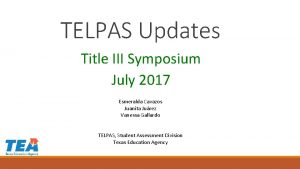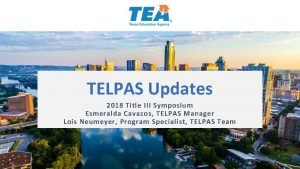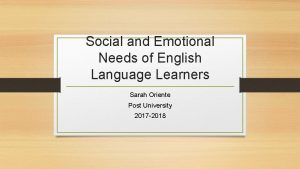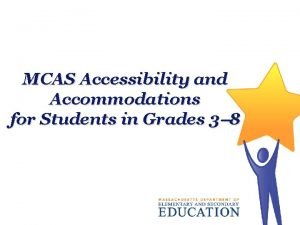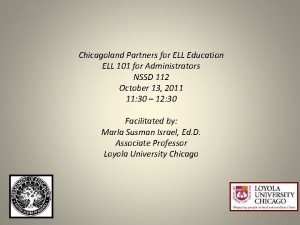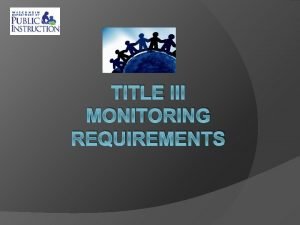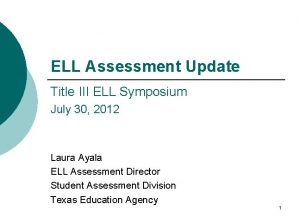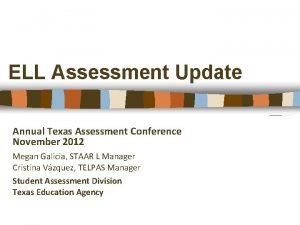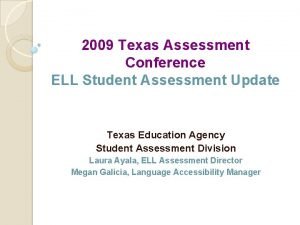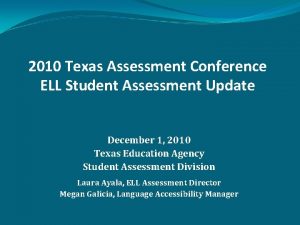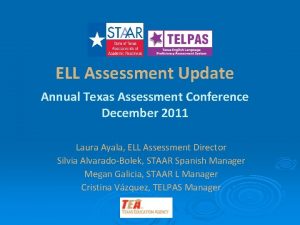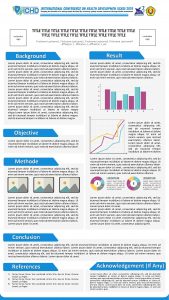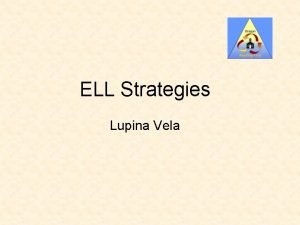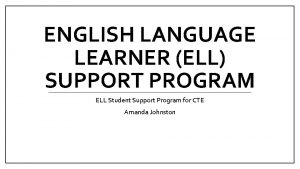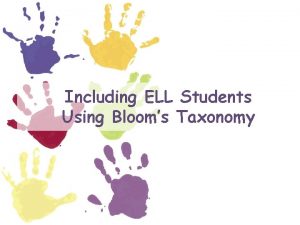ELL Assessment Update Title III ELL Symposium July























- Slides: 23

ELL Assessment Update Title III ELL Symposium July 30, 2012 Laura Ayala ELL Assessment Director Student Assessment Division Texas Education Agency 1

Disclaimer u These slides have been prepared by the Student Assessment Division of the Texas Education Agency u If any slide is changed for local use, please remove the TEA footer at the bottom of the slide TEA – ELL Assessment Update for July 2012 Title III ELL Symposium 2

Topics ¡ ¡ ELL Measure of Progress Alignment of TELPAS with Academic Language Demands of STAAR Preview of Topics for September Update TETN on ELL Assessment STAAR Performance TEA – ELL Assessment Update for July 2012 Title III ELL Symposium 3

Inclusion of ELLs in STAAR ¡ All ELLs participate in STAAR grade 3– 8 and EOC assessments ¡ TAC § 101. 1005(h) requires policies for including academic performance of ELLs in accountability measures to take into account second language acquisition developmental needs of this student population TEA – ELL Assessment Update for July 2012 Title III ELL Symposium 4

Key Components of Framework for ELL Assessment and Accountability ¡ ¡ ¡ Allow linguistic accommodations for all grades and subjects for assessments administered in English Acknowledge time it takes to learn English and impact on instruction, assessment, and accountability ¡ Struggling to understand English in class affects ability to learn challenging subject matter ¡ Difficulty understanding test questions in English affects ability to fully demonstrate knowledge and skills ¡ Avoid “one standard fits all” perceptions that disregard second language acquisition developmental processes and portray students and educational systems as failing Measure annual progress toward proficiency in both academic English and academic knowledge and skills, considering time it takes to learn English TEA – ELL Assessment Update for July 2012 Title III ELL Symposium 5

STAAR and TELPAS Relationship ¡ TELPAS is aligned with the Texas English Language Proficiency Standards (ELPS), which target development of academic English language proficiency ¡ By supporting development of academic English, ELPS support learning of content area TEKS ¡ As part of transition to more rigorous STAAR program, TEA will examine relationship of TELPAS to STAAR and make adjustments as needed to ensure strong link between academic language proficiency assessed on TELPAS and academic language demands of STAAR ¡ Implementation of STAAR-aligned TELPAS scheduled for spring 2014 TEA – ELL Assessment Update for July 2012 Title III ELL Symposium 6

Impetus for ELL-Specific Progress Measures in Texas Three main sources ― 1. Texas ELL Assessment Focus Group indicated: l Too often ELLs exempted and given LAT versions of TAKS were not part of campus and district focused efforts to help struggling students because LAT students were exempt from state reporting and accountability l For STAAR program, it would be better to eliminate exemptions and find fair and appropriate ways to assess ELLs and be accountable for meeting their unique needs TEA – ELL Assessment Update for July 2012 Title III ELL Symposium 7

Impetus for ELL-Specific Progress Measures in Texas Three main sources, continued ― 2. National ELL education policy experts now officially recommend that states create ELL-specific measures of annual progress for use in federal accountability systems 3. Policymakers and stakeholders would like fewer state vs. federal policy differences in new accountability system TEA – ELL Assessment Update for July 2012 Title III ELL Symposium 8

What kind of ELL progress measure is TEA exploring? ¡ TEA reviewed published recommendations of national Working Group on ELL Policy related to ELLs in federal accountability ¡ TEA is exploring following the recommendations, which advise using ELL progress measures that incorporate time needed for acquiring a second language into measures of ELLs’ academic achievement ¡ ELL progress measures we are exploring― l take into account that time needed to acquire English affects time needed to fully learn and demonstrate grade-level academic skills in English l apply to all content areas TEA – ELL Assessment Update for July 2012 Title III ELL Symposium 9

Recommendations of National Working Group on ELL Policy 1. Establish state-expected timeframe for second language acquisition o Make timeframe challenging but achievable o 4 to 5 years is policy group’s recommendation for a defensible timeframe based on best currently available second language acquisition research o ELLs are diverse; time required for second language acquisition is affected by many factors and individual student characteristics o This group recommends, however, that state’s timeline not exceed 5 years for an individual ELL TEA – ELL Assessment Update for July 2012 Title III ELL Symposium 10

Recommendations of National Working Group on ELL Policy 2. For ELLs tested in English, incorporate English language proficiency (ELP) into accountability provisions for content area achievement using expected timeframe from Recommendation 1 o Language plays significant role in knowledge acquisition and content mastery o Students should meet grade-level achievement standards no later than when they are expected to be proficient in English based on their initial ELP level and time in U. S. schools o Differentiate content-area performance expectations by expected ELP level for each grade TEA – ELL Assessment Update for July 2012 Title III ELL Symposium 11

Recommendations of National Working Group on ELL Policy 2. Continued… o Increase content-area performance expectations commensurate with expectations for increased ELP within state-established timeframe o In operationalizing progress measure, content-area performance expectations for a given ELL should be a function of ELL’s grade level and either expected level of ELP or current level if higher TEA – ELL Assessment Update for July 2012 Title III ELL Symposium 12

Recommendations of National Working Group on ELL Policy 3. Hold schools and districts accountable for meeting ELLs’ content-area performance expectations taking into account students’ level of ELP o All ELLs should achieve proficiency in English and meet grade-level performance standards in English within state’s timeframe for second language acquisition o A traditional one-size-fits-all performance standard ignores developmental role that language proficiency plays in learning of subject matter and “is enormously demoralizing and demotivating to both students and teachers” TEA – ELL Assessment Update for July 2012 Title III ELL Symposium 13

Recommendations of National Working Group on ELL Policy 3. Continued… o States should be held accountable for consistently improving the academic achievement of ELLs at each level of English language proficiency, as reflected by increasing the percentage of students at that level of ELP who also meet the performance benchmark for that level o When setting benchmarks tied to ELP levels, take into account state’s highest performing districts in examining what is ambitious yet realistic TEA – ELL Assessment Update for July 2012 Title III ELL Symposium 14

Ultimate Benefit Stated in National Working Group Recommendations Setting challenging but achievable goals for ELLs based on expected levels of ELP and a clearly delineated timeline for achieving both ELP and grade-level academic content standards will ― o o motivate teachers to ü provide content-area instruction at grade level for students regardless of their level of ELP and ü develop students’ academic language in support of content area achievement motivate students to engage in both language and content area learning TEA – ELL Assessment Update for July 2012 Title III ELL Symposium 15

What might an ELL progress measure look like in Texas? Current plan: Establish a state timeframe for becoming English proficient; then establish academic performance (progress) expectations for ELLs that increase progressively based on relationship between state’s expectations for learning English (measured by TELPAS) and subject matter (measured by STAAR) l Progress expectations to be annually increasing STAAR scale score expectations that culminate in STAAR Level II: Satisfactory standard at the timeframe’s “finish line” l STAAR progress expectations to align with challenging but reasonable expectations for learning academic English l Where the scale score expectations are set should support ability of ELLs to reach STAAR Level II standard within stateestablished timeframe TEA – ELL Assessment Update for July 2012 Title III ELL Symposium 16

ELL Progress Measure Conceptual Model Satisfactory • • This model illustrates basic idea under discussion Number of years in timeline and associated proficiency levels are TBD I (Intermediate), A (Advanced), H (Advanced High) E 1 -3: Annual graduated performance expectations on STAAR assessments in English in all content areas • LII: Level II Satisfactory on STAAR TEA – ELL Assessment Update for July 2012 Title III ELL Symposium

Notes on Intended Use ¡ Meeting annually increasing progress expectations on STAAR is not intended to “equate” to a passing score, and it is not intended to change EOC minimum score requirements ¡ The ELL progress measure is intended to provide information to use in helping ELLs get and stay on track to becoming academically proficient and English-language proficient in a reasonable and appropriate timeframe based on their starting level of English language proficiency l Why is this so important? In English instructional settings, the longer a student goes without being able to adequately understand use the language of instruction, the more likely it is for the student to fall behind academically and have difficulty catching up TEA – ELL Assessment Update for July 2012 Title III ELL Symposium 18

Upcoming Discussions and Decisions ¡ Whether and how to differentiate for extenuating circumstances of ELLs in the progress measure: l l l ¡ Unschooled ELL asylees/refugees Other immigrant ELLs who enter U. S. with little prior schooling First-year immigrant ELLs who enter U. S. schools late in school year ELLs who go back and forth between U. S. and another country (gaps in continuous schooling in U. S. ) within and across school years ELLs with a disability that significantly affects growth in second language acquisition Whether progress on TELPAS should be used in lieu of progress on STAAR for reading and/or writing for any period of time 19 TEA – ELL Assessment Update for July 2012 Title III ELL Symposium

Upcoming Discussions and Decisions ¡ ¡ What specific TELPAS expectations to use in setting progress measure expectations and whether to use TELPAS composite rating or individual domain scores Whether to include ELL progress measure information just in accountability calculations or also to include l l ¡ ¡ on STAAR Confidential Student Reports in student/teacher portal and/or on look-up chart on web Whether ELLs should be included just in an ELL progress measure or also in STAAR progress measure selected for overall student population How should STAAR L factor into SSI? Should recent immigrant ELLs and unschooled asylees/refugees be subject to SSI grade advancement requirements? If so, should meeting/not meeting ELL progress expectation be what is used for SSI grade advancement decisions? TEA – ELL Assessment Update for July 2012 Title III ELL Symposium 20

Timeline for Implementation of ELL Progress Measure ¡ An ELL-specific progress measure is scheduled to be available starting with the spring 2014 test administrations ¡ Decisions will need to be made about how to handle the test results of new and recent immigrant ELLs and unschooled ELL asylees and refugees for spring 2013 accountability Accountability system decisions are coordinated through TEA Performance Reporting Unit (not Student Assessment Division) TEA – ELL Assessment Update for July 2012 Title III ELL Symposium 21

Topics for September 12 TETN (Fall ELL Assessment Update Event # 15580) ¡ ¡ ¡ ¡ News about STAAR L for 2013 – online assessment program for grades 3 -8 and high school Student Assessment Division to provide ESC training of trainers on LPAC assessment decisions earlier this year SSI policies related to recent immigrant ELLs and unschooled asylees/refugees LPAC decision-making for fall EOC assessments Review of ELL assessment policies; more guidance on English I and II special provisions for qualifying ELLs News about any data collection changes through TELPAS or STAAR related to ELLs Review of standard setting plans for grades 3 -8 Plans for ELL progress measure and TELPAS-STAAR alignment TEA – ELL Assessment Update for July 2012 Title III ELL Symposium 22

STAAR Performance ¡ See statewide results at http: //www. tea. state. tx. us/student. assessment/results/ ¡ Average raw scores (items correct) for grades 3 -8 ¡ Percent passing at current phase-in standard for EOC ¡ Numbers of ELLs tested with STAAR, STAAR Spanish, and STAAR L TEA – ELL Assessment Update for July 2012 Title III ELL Symposium 23
 Title iii symposium
Title iii symposium Telpas headphones
Telpas headphones Is an alternative of log based recovery
Is an alternative of log based recovery Hamlet act iii scene ii
Hamlet act iii scene ii Social emotional needs of ell students
Social emotional needs of ell students Mcas test nav
Mcas test nav Ell 101
Ell 101 Quizizz
Quizizz Label of cells
Label of cells Stages of ell
Stages of ell Ell specialist
Ell specialist Karina ell
Karina ell Karina ell
Karina ell Karina ell
Karina ell Karina ell
Karina ell Karina ell
Karina ell Karina ell
Karina ell Karina ell
Karina ell Ell student profile
Ell student profile National association of hbcu title iii administrators
National association of hbcu title iii administrators Title iii eligibility
Title iii eligibility Title iii requirements
Title iii requirements Reports and proposals
Reports and proposals Title title
Title title
